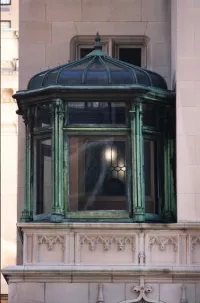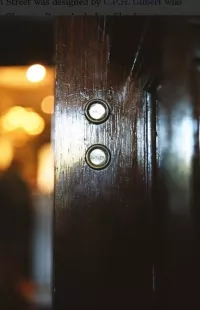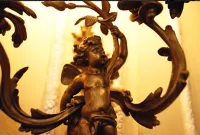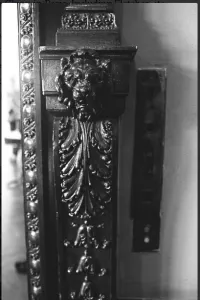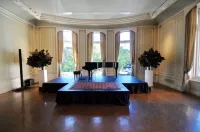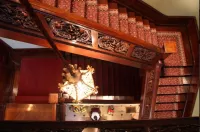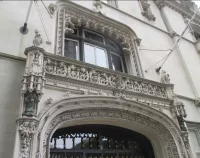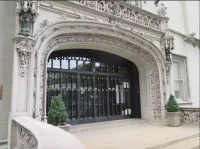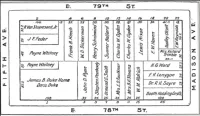Share what you know,
and discover more.
Share what you know,
and discover more.
Mar 07, 2023
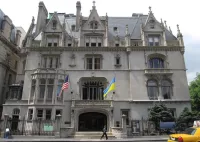
-

- Charmaine Bantugan
Ukrainian Institute Of America
Elizabeth Pickering (1847-1914). This 5-story limestone chateau on the southeast corner of Fifth Avenue and East 79th Street was designed by C.P.H. Gilbert who took influence from the 15th Century Hôtel de Cluny in Paris. Including Fletcher, its private occupants derived their fortunes from tar, oil, and turf. The occupant who attracted the most attention was Harry F. Sinclair who left after serving six-and-a-half months in jail, and for 23-years it was home to the reclusive last male lineal descendant of Peter Stuyvesant, last Governor of New Amsterdam. Since 1955, it has served as the Ukrainian Institute of America, promoting Ukrainian culture, art, music & history, and is open to the public. It featured in the popular TV series Gossip Girl and starred as Valmont House, the fictional home of the Valmont and Merteuil families in Cruel Intentions. Overlooking Central Park, the chateau has a frontage of 100-feet on East 79th Street and 32.2-feet on Fifth Avenue where it neighbors the Cook and Payne-Whitney Mansions. Fletcher bought the plot from Henry H. Cook who in 1880 had bought up the block from 78th to 79th Streets and Fifth to Madison Avenues (the 'Cook Block') for just $500,000. Isaac D. Fletcher came to New York from Maine in 1865 and over the next thirty years amassed a $5-million fortune as President of the Barrett Manufacturing Company and the New York Coal Tar Company. In 1897, he commissioned the blue-blooded but still relatively unknown architect, C.P.H. Gilbert, to build him something out of the ordinary as a worthy home for his valuable collection of European art. Gratifying his client, Gilbert - a well-travelled graduate of the École des Beaux-Arts in Paris - chose to borrow the principal stylistic features of the Gothic/Renaissance Hôtel de Cluny to bring to life Old Paris in New York. But, "chateaux" on American streets were then still an unfamiliar sight and its arrival prompted one perplexed critic to comment: "too much the air of an archeological reproduction to be accepted as an appropriate New York City house of 1898". Despite that critic's crusted opinion, the house Gilbert built here for Fletcher was immediately admired and his particular version of the chateauesque style went on to win him several of his most valuable commissions: He most famously replicated it 1901 for F.W. Woolworth's 990 Fifth Avenue, and again for the Felix Warburg Mansion. Fletcher filled his new home with one of the city's most important art collections. Yet, while his glimmering limestone chateau was anything but inconspicuous, his presence as an art collector - both in New York and Europe - most certainly was: never attending sales himself, he was always represented by one of his agents. He was equally secretive about his intentions for the collection in the event of his death so it was a welcome surprise to the Metropolitan Museum when he left them not only his entire art collection (valued at over a million dollars), but also the house in which it was kept. Fletcher's collection included David, Gainsborough, Rembrandt, Reynolds, Rubens, Corot, etc. Harry Sinclair & the Teapot Dome Scandal In 1918, to establish the Fletcher Fund for the purpose of acquiring further artwork, the museum sold the house to Harry Ford Sinclair who started life as a pharmacist in Kansas before striking it rich prospecting for oil "on a shoestring" in Oklahoma. In 1916, he established the Sinclair Organization which already boasted assets of $51-million and in 1917 he met with Lenin in Russia, unsuccessfully attempting to negotiate the oil rights in Siberia. Always sailing close to the wind, in 1924 he found himself at the center of the Teapot Dome Scandal - a bribery scandal involving the administration of U.S. President Warren G. Harding. Sinclair was charged with conspiracy to defraud the government. He was acquitted, but the other central figure in the scandal, U.S. Secretary of the Interior Albert B. Fall, became the first cabinet member to be sentenced to prison. Sinclair may have thought he dodged a bullet, but in 1929 he was put away for 6.5-months for contempt of court, and contempt of the U.S. Senate, when it came to light that he'd hired detectives to "shadow" the members of the jury. The repercussions from the scandal saw him become 'persona non grata' in New York, but moving to California and with the full support of his directors and 80,000 stock-holders, by the time he died, he'd made the Sinclair Organization an international concern worth $1.2 billion. Its green dinosaur logo remains a familiar sight at over 2000-service stations in 21 U.S. states. A workaholic who kept irregular hours and didn't take vacations, Sinclair's chateau here on Fifth Avenue was less a home and more akin to something along the lines of a trophy wife: it made him look good to his investors. Having bought it in pristine condition, the only change he made was to add an automatic pipe organ - yesteryear's 'surround sound'! The Fall of the House of Stuyvesant In 1930, Sinclair and New York parted ways, and his mansion was sold for $450,000 to the unmarried siblings Augustus and Anne Stuyvesant - the last descendants to still bear the name of the peg-legged Peter Stuyvesant, last Governor of New Amsterdam. The year before, they had developed the site of their "imposing" home at 3 East 57th Street, next to the infamous Mary Mason Jones Mansion, and moved into the Savoy Plaza Hotel. When Anne died here in 1938 it was reported that 72-mansions remained in private ownership on Fifth Avenue, although 33-were closed. It was estimated that $30,000 a year was the bare minimum required to maintain an average-sized house on the Avenue. The Stuyvesant chateau was one of the few that remained open, but Augustus wasn't so much enjoying his wealth as enduring it. He lived here alone except for a chauffeur, butler, valet, and a housekeeping staff of four. A virtual recluse, he ate "utterly alone at the big dining room table... served by (Ernest) Vernon, the butler, and an assistant footman". A favorite hobby of his was to sit in front of a picture of Franklin D. Roosevelt... and cuss. Ernest Vernon had entered into service with Stuyvesant in 1920. For 33-years, he never once took a vacation and yet recalled that he and his master, "were perfect strangers... no-one ever passed the time of day with Mr. Stuyvesant". But nonetheless, when Stuyvesant died, it was reported that in the front left pew his 70-year old, "white-haired, ruddy-faced butler, dressed in formal black, sat alone, weeping into a handkerchief". Three months after Stuyvesant's death in 1953, an auction was held at the chateau. The furnishing that went under the hammer were predominantly French (eg., a 250-piece dinner service) although there was also silver dating from 18th Century New York. Several heirlooms had already been removed by relatives such as the 12-family portraits in the Drawing Room (including that of Peter Stuyvesant himself) and a genealogical chart of the Stuyvesant family that were presented to the New-York Historical Society. In the identical wills of Augustus and Anne Stuyvesant, they directed that the family's portraits and miniatures be destroyed (not wanting them sold out of the family for a handful of dollars), but their wills were challenged in court and the heirlooms were rescued for posterity. Perhaps having a premonition of what would happen, in a rare interview in the 1940s, Augustus Stuyvesant said: "We see so many wills broken. Whether they'll break mine or not, I don't know. You can never tell what they'll do after you die". The Ukrainian Institute of America In 1955, after sitting empty for two years, it was granted a new lease of life when it was purchased at auction by William Dzus, an Ukrainian-American engineer who made a fortune though his invention of self-locking metal fasteners for aircraft equipment. In 1948, he founded the Ukrainian Institute of America and purchased the house to serve as its home - a cultural center promoting Ukrainian culture, art, music and history, as it continues to do so today. It has been meticulously maintained by the Institute and is remarkable for how little the original interior has changed since the Fletchers first stepped foot in it. It's open to the public and passers-by are welcome to look around.
Ukrainian Institute Of America
Elizabeth Pickering (1847-1914). This 5-story limestone chateau on the southeast corner of Fifth Avenue and East 79th Street was designed by C.P.H. Gilbert who took influence from the 15th Century Hôtel de Cluny in Paris. Including Fletcher, its private occupants derived their fortunes from tar, oil, and turf. The occupant who attracted the most attention was Harry F. Sinclair who left after serving six-and-a-half months in jail, and for 23-years it was home to the reclusive last male lineal descendant of Peter Stuyvesant, last Governor of New Amsterdam. Since 1955, it has served as the Ukrainian Institute of America, promoting Ukrainian culture, art, music & history, and is open to the public. It featured in the popular TV series Gossip Girl and starred as Valmont House, the fictional home of the Valmont and Merteuil families in Cruel Intentions. Overlooking Central Park, the chateau has a frontage of 100-feet on East 79th Street and 32.2-feet on Fifth Avenue where it neighbors the Cook and Payne-Whitney Mansions. Fletcher bought the plot from Henry H. Cook who in 1880 had bought up the block from 78th to 79th Streets and Fifth to Madison Avenues (the 'Cook Block') for just $500,000. Isaac D. Fletcher came to New York from Maine in 1865 and over the next thirty years amassed a $5-million fortune as President of the Barrett Manufacturing Company and the New York Coal Tar Company. In 1897, he commissioned the blue-blooded but still relatively unknown architect, C.P.H. Gilbert, to build him something out of the ordinary as a worthy home for his valuable collection of European art. Gratifying his client, Gilbert - a well-travelled graduate of the École des Beaux-Arts in Paris - chose to borrow the principal stylistic features of the Gothic/Renaissance Hôtel de Cluny to bring to life Old Paris in New York. But, "chateaux" on American streets were then still an unfamiliar sight and its arrival prompted one perplexed critic to comment: "too much the air of an archeological reproduction to be accepted as an appropriate New York City house of 1898". Despite that critic's crusted opinion, the house Gilbert built here for Fletcher was immediately admired and his particular version of the chateauesque style went on to win him several of his most valuable commissions: He most famously replicated it 1901 for F.W. Woolworth's 990 Fifth Avenue, and again for the Felix Warburg Mansion. Fletcher filled his new home with one of the city's most important art collections. Yet, while his glimmering limestone chateau was anything but inconspicuous, his presence as an art collector - both in New York and Europe - most certainly was: never attending sales himself, he was always represented by one of his agents. He was equally secretive about his intentions for the collection in the event of his death so it was a welcome surprise to the Metropolitan Museum when he left them not only his entire art collection (valued at over a million dollars), but also the house in which it was kept. Fletcher's collection included David, Gainsborough, Rembrandt, Reynolds, Rubens, Corot, etc. Harry Sinclair & the Teapot Dome Scandal In 1918, to establish the Fletcher Fund for the purpose of acquiring further artwork, the museum sold the house to Harry Ford Sinclair who started life as a pharmacist in Kansas before striking it rich prospecting for oil "on a shoestring" in Oklahoma. In 1916, he established the Sinclair Organization which already boasted assets of $51-million and in 1917 he met with Lenin in Russia, unsuccessfully attempting to negotiate the oil rights in Siberia. Always sailing close to the wind, in 1924 he found himself at the center of the Teapot Dome Scandal - a bribery scandal involving the administration of U.S. President Warren G. Harding. Sinclair was charged with conspiracy to defraud the government. He was acquitted, but the other central figure in the scandal, U.S. Secretary of the Interior Albert B. Fall, became the first cabinet member to be sentenced to prison. Sinclair may have thought he dodged a bullet, but in 1929 he was put away for 6.5-months for contempt of court, and contempt of the U.S. Senate, when it came to light that he'd hired detectives to "shadow" the members of the jury. The repercussions from the scandal saw him become 'persona non grata' in New York, but moving to California and with the full support of his directors and 80,000 stock-holders, by the time he died, he'd made the Sinclair Organization an international concern worth $1.2 billion. Its green dinosaur logo remains a familiar sight at over 2000-service stations in 21 U.S. states. A workaholic who kept irregular hours and didn't take vacations, Sinclair's chateau here on Fifth Avenue was less a home and more akin to something along the lines of a trophy wife: it made him look good to his investors. Having bought it in pristine condition, the only change he made was to add an automatic pipe organ - yesteryear's 'surround sound'! The Fall of the House of Stuyvesant In 1930, Sinclair and New York parted ways, and his mansion was sold for $450,000 to the unmarried siblings Augustus and Anne Stuyvesant - the last descendants to still bear the name of the peg-legged Peter Stuyvesant, last Governor of New Amsterdam. The year before, they had developed the site of their "imposing" home at 3 East 57th Street, next to the infamous Mary Mason Jones Mansion, and moved into the Savoy Plaza Hotel. When Anne died here in 1938 it was reported that 72-mansions remained in private ownership on Fifth Avenue, although 33-were closed. It was estimated that $30,000 a year was the bare minimum required to maintain an average-sized house on the Avenue. The Stuyvesant chateau was one of the few that remained open, but Augustus wasn't so much enjoying his wealth as enduring it. He lived here alone except for a chauffeur, butler, valet, and a housekeeping staff of four. A virtual recluse, he ate "utterly alone at the big dining room table... served by (Ernest) Vernon, the butler, and an assistant footman". A favorite hobby of his was to sit in front of a picture of Franklin D. Roosevelt... and cuss. Ernest Vernon had entered into service with Stuyvesant in 1920. For 33-years, he never once took a vacation and yet recalled that he and his master, "were perfect strangers... no-one ever passed the time of day with Mr. Stuyvesant". But nonetheless, when Stuyvesant died, it was reported that in the front left pew his 70-year old, "white-haired, ruddy-faced butler, dressed in formal black, sat alone, weeping into a handkerchief". Three months after Stuyvesant's death in 1953, an auction was held at the chateau. The furnishing that went under the hammer were predominantly French (eg., a 250-piece dinner service) although there was also silver dating from 18th Century New York. Several heirlooms had already been removed by relatives such as the 12-family portraits in the Drawing Room (including that of Peter Stuyvesant himself) and a genealogical chart of the Stuyvesant family that were presented to the New-York Historical Society. In the identical wills of Augustus and Anne Stuyvesant, they directed that the family's portraits and miniatures be destroyed (not wanting them sold out of the family for a handful of dollars), but their wills were challenged in court and the heirlooms were rescued for posterity. Perhaps having a premonition of what would happen, in a rare interview in the 1940s, Augustus Stuyvesant said: "We see so many wills broken. Whether they'll break mine or not, I don't know. You can never tell what they'll do after you die". The Ukrainian Institute of America In 1955, after sitting empty for two years, it was granted a new lease of life when it was purchased at auction by William Dzus, an Ukrainian-American engineer who made a fortune though his invention of self-locking metal fasteners for aircraft equipment. In 1948, he founded the Ukrainian Institute of America and purchased the house to serve as its home - a cultural center promoting Ukrainian culture, art, music and history, as it continues to do so today. It has been meticulously maintained by the Institute and is remarkable for how little the original interior has changed since the Fletchers first stepped foot in it. It's open to the public and passers-by are welcome to look around.
Mar 07, 2023
Ukrainian Institute Of America
Elizabeth Pickering (1847-1914). This 5-story limestone chateau on the southeast corner of Fifth Avenue and East 79th Street was designed by C.P.H. Gilbert who took influence from the 15th Century Hôtel de Cluny in Paris. Including Fletcher, its private occupants derived their fortunes from tar, oil, and turf. The occupant who attracted the most attention was Harry F. Sinclair who left after serving six-and-a-half months in jail, and for 23-years it was home to the reclusive last male lineal descendant of Peter Stuyvesant, last Governor of New Amsterdam. Since 1955, it has served as the Ukrainian Institute of America, promoting Ukrainian culture, art, music & history, and is open to the public. It featured in the popular TV series Gossip Girl and starred as Valmont House, the fictional home of the Valmont and Merteuil families in Cruel Intentions.Overlooking Central Park, the chateau has a frontage of 100-feet on East 79th Street and 32.2-feet on Fifth Avenue where it neighbors the Cook and Payne-Whitney Mansions. Fletcher bought the plot from Henry H. Cook who in 1880 had bought up the block from 78th to 79th Streets and Fifth to Madison Avenues (the 'Cook Block') for just $500,000.
Isaac D. Fletcher came to New York from Maine in 1865 and over the next thirty years amassed a $5-million fortune as President of the Barrett Manufacturing Company and the New York Coal Tar Company. In 1897, he commissioned the blue-blooded but still relatively unknown architect, C.P.H. Gilbert, to build him something out of the ordinary as a worthy home for his valuable collection of European art. Gratifying his client, Gilbert - a well-travelled graduate of the École des Beaux-Arts in Paris - chose to borrow the principal stylistic features of the Gothic/Renaissance Hôtel de Cluny to bring to life Old Paris in New York. But, "chateaux" on American streets were then still an unfamiliar sight and its arrival prompted one perplexed critic to comment: "too much the air of an archeological reproduction to be accepted as an appropriate New York City house of 1898".
Despite that critic's crusted opinion, the house Gilbert built here for Fletcher was immediately admired and his particular version of the chateauesque style went on to win him several of his most valuable commissions: He most famously replicated it 1901 for F.W. Woolworth's 990 Fifth Avenue, and again for the Felix Warburg Mansion.
Fletcher filled his new home with one of the city's most important art collections. Yet, while his glimmering limestone chateau was anything but inconspicuous, his presence as an art collector - both in New York and Europe - most certainly was: never attending sales himself, he was always represented by one of his agents. He was equally secretive about his intentions for the collection in the event of his death so it was a welcome surprise to the Metropolitan Museum when he left them not only his entire art collection (valued at over a million dollars), but also the house in which it was kept. Fletcher's collection included David, Gainsborough, Rembrandt, Reynolds, Rubens, Corot, etc.
Harry Sinclair & the Teapot Dome Scandal
In 1918, to establish the Fletcher Fund for the purpose of acquiring further artwork, the museum sold the house to Harry Ford Sinclair who started life as a pharmacist in Kansas before striking it rich prospecting for oil "on a shoestring" in Oklahoma. In 1916, he established the Sinclair Organization which already boasted assets of $51-million and in 1917 he met with Lenin in Russia, unsuccessfully attempting to negotiate the oil rights in Siberia. Always sailing close to the wind, in 1924 he found himself at the center of the Teapot Dome Scandal - a bribery scandal involving the administration of U.S. President Warren G. Harding. Sinclair was charged with conspiracy to defraud the government. He was acquitted, but the other central figure in the scandal, U.S. Secretary of the Interior Albert B. Fall, became the first cabinet member to be sentenced to prison.
Sinclair may have thought he dodged a bullet, but in 1929 he was put away for 6.5-months for contempt of court, and contempt of the U.S. Senate, when it came to light that he'd hired detectives to "shadow" the members of the jury. The repercussions from the scandal saw him become 'persona non grata' in New York, but moving to California and with the full support of his directors and 80,000 stock-holders, by the time he died, he'd made the Sinclair Organization an international concern worth $1.2 billion. Its green dinosaur logo remains a familiar sight at over 2000-service stations in 21 U.S. states.
A workaholic who kept irregular hours and didn't take vacations, Sinclair's chateau here on Fifth Avenue was less a home and more akin to something along the lines of a trophy wife: it made him look good to his investors. Having bought it in pristine condition, the only change he made was to add an automatic pipe organ - yesteryear's 'surround sound'!
The Fall of the House of Stuyvesant
In 1930, Sinclair and New York parted ways, and his mansion was sold for $450,000 to the unmarried siblings Augustus and Anne Stuyvesant - the last descendants to still bear the name of the peg-legged Peter Stuyvesant, last Governor of New Amsterdam. The year before, they had developed the site of their "imposing" home at 3 East 57th Street, next to the infamous Mary Mason Jones Mansion, and moved into the Savoy Plaza Hotel.
When Anne died here in 1938 it was reported that 72-mansions remained in private ownership on Fifth Avenue, although 33-were closed. It was estimated that $30,000 a year was the bare minimum required to maintain an average-sized house on the Avenue. The Stuyvesant chateau was one of the few that remained open, but Augustus wasn't so much enjoying his wealth as enduring it. He lived here alone except for a chauffeur, butler, valet, and a housekeeping staff of four. A virtual recluse, he ate "utterly alone at the big dining room table... served by (Ernest) Vernon, the butler, and an assistant footman". A favorite hobby of his was to sit in front of a picture of Franklin D. Roosevelt... and cuss.
Ernest Vernon had entered into service with Stuyvesant in 1920. For 33-years, he never once took a vacation and yet recalled that he and his master, "were perfect strangers... no-one ever passed the time of day with Mr. Stuyvesant". But nonetheless, when Stuyvesant died, it was reported that in the front left pew his 70-year old, "white-haired, ruddy-faced butler, dressed in formal black, sat alone, weeping into a handkerchief".
Three months after Stuyvesant's death in 1953, an auction was held at the chateau. The furnishing that went under the hammer were predominantly French (eg., a 250-piece dinner service) although there was also silver dating from 18th Century New York. Several heirlooms had already been removed by relatives such as the 12-family portraits in the Drawing Room (including that of Peter Stuyvesant himself) and a genealogical chart of the Stuyvesant family that were presented to the New-York Historical Society.
In the identical wills of Augustus and Anne Stuyvesant, they directed that the family's portraits and miniatures be destroyed (not wanting them sold out of the family for a handful of dollars), but their wills were challenged in court and the heirlooms were rescued for posterity. Perhaps having a premonition of what would happen, in a rare interview in the 1940s, Augustus Stuyvesant said: "We see so many wills broken. Whether they'll break mine or not, I don't know. You can never tell what they'll do after you die".
The Ukrainian Institute of America
In 1955, after sitting empty for two years, it was granted a new lease of life when it was purchased at auction by William Dzus, an Ukrainian-American engineer who made a fortune though his invention of self-locking metal fasteners for aircraft equipment. In 1948, he founded the Ukrainian Institute of America and purchased the house to serve as its home - a cultural center promoting Ukrainian culture, art, music and history, as it continues to do so today. It has been meticulously maintained by the Institute and is remarkable for how little the original interior has changed since the Fletchers first stepped foot in it. It's open to the public and passers-by are welcome to look around.
Posted Date
Mar 07, 2023
Historical Record Date
Mar 07, 2023
Source Name
House Histree
Source Website
Delete Story
Are you sure you want to delete this story?


